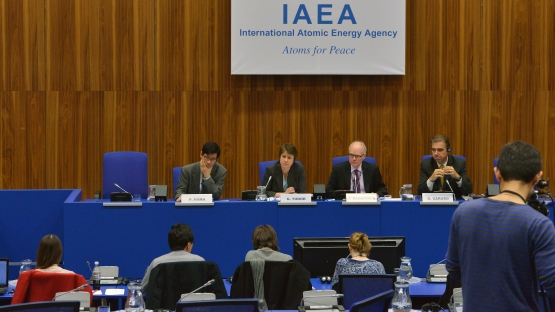States should develop and implement a national strategy in relation to building and maintaining competence in radiation protection. This was among the conclusions made at the close of the International Experts' Meeting (IEM) on Radiation Protection after the Fukushima Daiichi Accident: Promoting Confidence and Understanding. More than 500 participants representing 75 IAEA Member States and 12 international organizations attended the week-long meeting.
This is the sixth International Experts' Meeting in a series of meetings held as part the Action Plan on Nuclear Safety, implemented in response to the Fukushima Daiichi Nuclear Power Plant accident in March 2011. The Action Plan sets out a comprehensive programme of work, in 12 major areas, to strengthen nuclear safety worldwide. Each of the IEMs focus on a different aspect of the Action Plan to analyse all relevant technical aspects and learn the lessons from the Fukushima Daiichi accident. IEM6 provided a forum for Member States to exchange information and experience related to radiation protection as follows:
- Identifying the key radiation protection issues to be addressed by the international community;
- Enhancing long-term strategies in response to nuclear or radiological accidents;
- Assisting IAEA Member States in reviewing and updating their radiation protection programmes as appropriate; and
- Supporting the IAEA's work in the area of radiation protection.
An important viewpoint shared throughout the meeting was that people affected by radiological incidents should have the right to be involved in the response.
"Their lives have been directly affected and therefore they have a right to full involvement in the design, implementation and review of the effectiveness of the measures being implemented to reduce their radiation dose," said Mr. Sigurdur Magnusson, the meeting Chairperson, in delivering the concluding summary of the sixth IEM on 21 February 2014.
The meeting also addressed risk communication issues, and how to convey radiation exposure information effectively and understandably to the public. To be successful, as pointed out in the IEM summary, decision makers must also work with the public, informing them about emergency preparations and actions that will be taken in the event of a nuclear or radiological incident.
Involving Young Professionals
IEM6 took a unique approach of involving the participation of young professionals from different scientific fields. The aim was to generate a wider understanding among this age group of overall radiation protection issues, as well as radiation safety programmes that the IAEA and its Member States are implementing in light of the lessons learned from the Fukushima Daiichi nuclear accident.
In the IEM's organizational phase, young professionals - those with less than ten years of working experience in the field - were invited to submit abstracts and posters pertaining to the theme of the meeting. Then at the meeting itself, they were provided with the opportunity to co-chair sessions, which in turn, facilitated intergenerational sharing of experience, knowledge and insights.
Mr. Saidou of the Institute of Geological and Mining Research and a participating young professional from Cameroon, pointed out that "radiation protection is important for everyone, even in places without nuclear power."
"The world population receives varying degrees of radiation from natural sources depending on elevation and the constituents of the earth beneath," Mr. Saidou said.
Another participating young professional, Ms. Nancy Puerta of the Regulatory Authority of Argentina, emphasized how "it is vital for decision makers to ensure that assistance and recommendations are clear and precise in the precautions and standards that are required to be in place in order to avoid radiological risks."
A formal report on the summary and findings of IEM6 will be published soon, and includes the presentations and discussions. This will also be made available on the IAEA website.
Two more International Experts' Meetings are scheduled to take place in connection with the IAEA Action Plan on Nuclear Safety. The next one on Severe Accident Management in the Light of the Accident at the Fukushima Daiichi Nuclear Power Plant will take place at the IAEA's headquarters from 17 to 20 March 2014.



